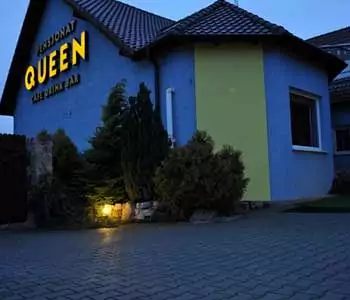Gmina Łęknica (urban gmina) Climate Cfb Area 16.4 km² Population 2,641 (2006) | County Żary Postal code 68-208 Local time Sunday 5:46 PM | |
 | ||
Weather 17°C, Wind W at 11 km/h, 57% Humidity Points of interest Rezerwat kulturowy "Park Mu, Trasa Geoturystyczna „Dawna K, Rezerwat przyrody Nad Młyń | ||
Łęknica [wɛŋkˈɲit͡sa] (German: Lugknitz; Upper Sorbian: Wjeska) is a border town in western Poland, one of the two gminas of Żary County in Lubusz Voivodeship.
Contents
Map of %C5%81%C4%99knica, Poland
Geography
The town is situated in the Polish part of the historic Upper Lusatia region, in the broad valley of the Neisse river, which forms the border with Germany. A bridge across the river connects it with the opposite German town of Bad Muskau, another border crossing in the south leads to Krauschwitz. Łęknica's population numbers 2,648 (2004).
Muskau Park (Park Mużakowski), a Polish-German World Heritage Site, stretches north of the town centre.
History
The area along the Neisse river was already settled in the Bronze Age. While neighbouring Muskau was already mentioned in 1249 and was awarded city rights in 1452, the village of Lugnitz was first documented in 1505, then part of the Muskau state country.
According to the 1635 Peace of Prague, Lugknitz together with Upper Lusatia passed from the Bohemian Crown to the Electorate of Saxony. Upon the Congress of Vienna in 1815, it was ceded to Prussia and incorporated into the Province of Silesia. About 1880 it was still a small Sorbian agricultural village, one of only two Sorbian-speaking settlements east of the Neisse river, the other being Braunsdorf (Brunojcy). That changed with the turn of century, when industry was established on the Neisse. Brown coal started to be mined. Based on rich clay deposits, ceramic companies emerged and also glass factories.
During World War II, 70% of the city was destroyed, as well as much of the industry (brown coal mine "Babina" from 40%, glassworks 30% and slate factories 50%). The town was separated from Bad Muskau by the new state border along the Oder–Neisse line, the remaining German population was expelled and the place was gradually settled with Polish military veterans, refugees, people returning from forced labour, people repatriated from France, Belgium and in 1958 18 families repatriated from the USSR settled in the city.
The settlement changed name several times, Łuknica in 1945–1947, then Ługnica and Łęknice. It received the name Łęknica in 1956 and obtained town privileges in 1969.
